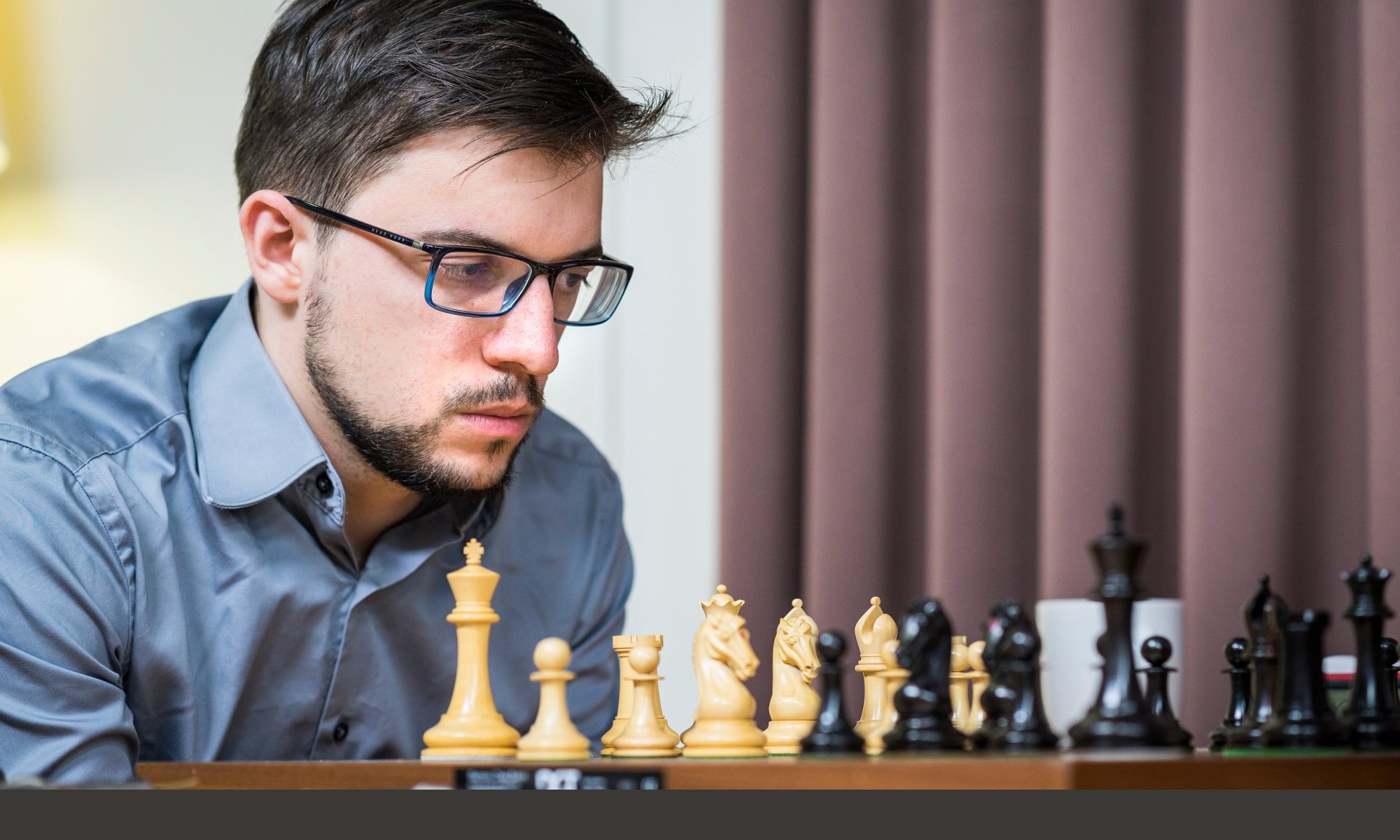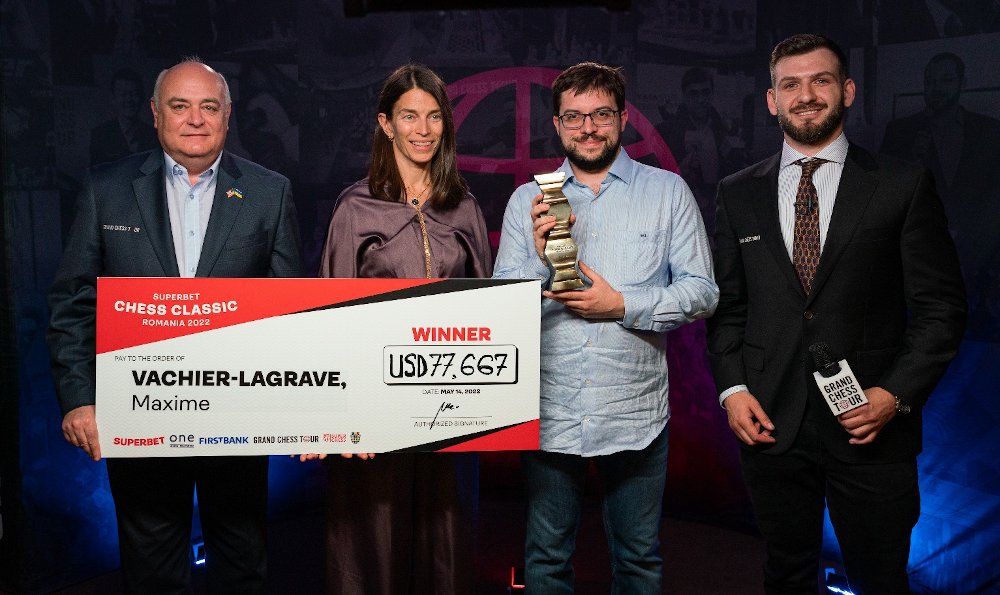After the disappointment of the Fide Grand Prix, I had taken the time to decompress, in order to have a break and recharge my batteries. So, I was a bit in the unknown when I arrived in Bucharest, in the sense that I didn’t know what it would be like without specific preparation. Important parameter also, the Fide had just announced that the Grand Chess Tour 2023 would qualify two players for the 2024 Candidates, giving to the 2022 edition an additional interest; to keep one’s place in the circuit for the following year!
On this subject, I will say two words. On the one hand, it’s a good thing in that it gives the Tour an extra stake; that was a bit of a problem in previous seasons, this disconnection of the Pro Tour from the World Championship cycle.
However, if we kept the current format of 9 Full Tour players in 2023, I think we would have too few candidates for the first two places; moreover, if Carlsen and his challenger were included, this number would then drop to 7! So clearly for me, we should introduce qualifying tournaments in 2023, and obviously increase the number of Full Tour players.
However, if we keep the current format of 9 players – or even 7 if Carlsen and his challenger don’t participate – we have too few players fighting for the two places. So clearly for me, in 2023, we should introduce qualifying tournaments, and obviously increase the number of full Tour players involved.
Round 1: MVL-DOMINGUEZ 1/2
It was a pretty good start because I think I maneuvered pretty well and got a small advantage against his Petrov. Maybe I didn’t believe enough in my chances, especially in the final position; but I thought I had let some of my advantage slip away and I was even afraid I could become worse if I pushed too hard.
Round 2: SO-MVL 1/2
A game that marks the arrival of the Queen’s Gambit Accepted in my repertoire, even though I had already used it in Rapid. I figured it was the right time; obviously, this option had been in the air for several months… I didn’t have much trouble getting out of the opening. But you can still feel my lack of experience with this type of position, which is symmetrical and almost equal, but which you have to play very precisely to completely equalize; there are often two or three quite subtle moves to find.
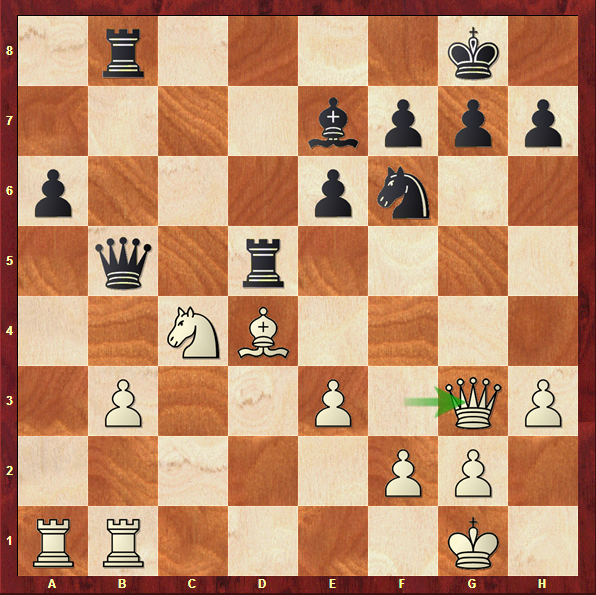
For example, one of the subtle moves here would have been to avoid playing 21…Rg5?! which could have caused me some problems had Wesley not opted for the repetition after 22.Qf3 Rd5, but chosen 22.Qf4 (threatening 23.Ra5 or 23.Rxa6) 22…Nd5 23.Qf3, and the Rook is not at ease on g5. Instead, I should have returned to d8 with the Rook (21…Rdd8), which is not necessarily trivial, is it?

Round 3: MVL-MAMEDYAROV 1/2
A rather quick draw due to the fact that at the end of the opening – a Caro-Kann that I had hardly anticipated – I opted for a plan with a Nd2-c4 maneuver that I interrupted halfway, as I did not like the resulting position.
Round 4: MVL-CARUANA
The Open Spanish, and in particular the Dillworth Attack (11…Nxf2) was one of the options I had prepared against.
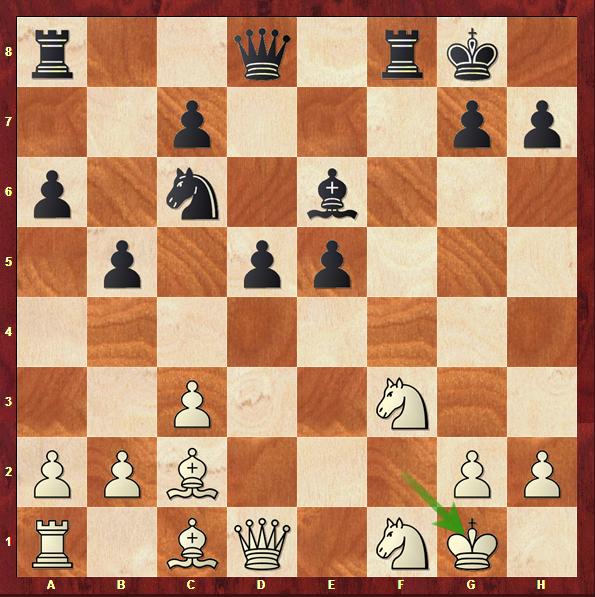
Here I was mostly expecting 15…Qd6 or 15…Bg4, the main moves of the position, but he surprised me with 15…Qd7.
Obviously, I understood his idea on the board; with the Queen on d6, white plays 16.Be3 and prevents 16…Bg4? because of 17.Bxh7+! Kh8 (17…Kxh7 18.Ng5+) 18.Qe1 Bxf3 19.Qh4. On the other hand after 15…Qd7, if white plays the normal 16.Be3 (as he does on 15…Qd6), then 16…Bg4 is possible, since the Qd7 protects the Bishop.
So I reacted differently with 16.Bg5, knowing that I was taking the risk that he was still in his prep, even though I hoped that 16.Bg5 would not be the main move. Unfortunately, he continued to blitz out his moves: 16…Rae8 17.Qd2 d4!; a reply played a tempo, which hurts even more because it was not a move I expected; I thought he would rather not touch his center…
Finally, after 18.Ng3, he started to think, and played 18…h6 19.Bh4 (but not 19.Qd3? Bf5 20.Nxf5 e4!) 19…dxc3.
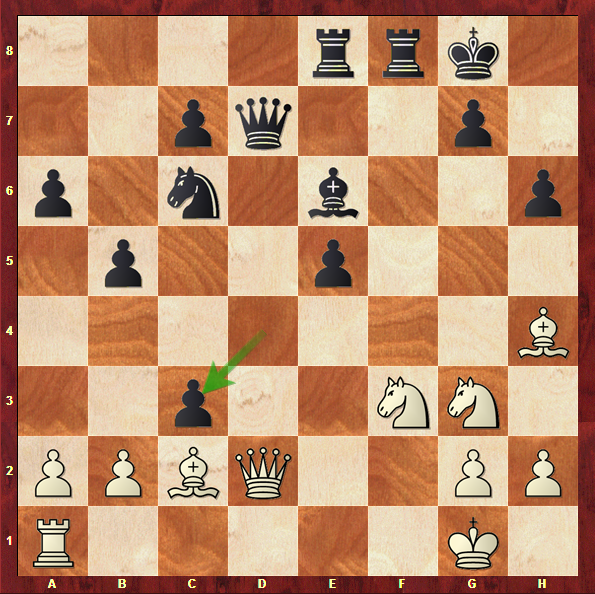
Here my initial idea was 20.Qxd7 Bxd7 21.bxc3 g5 22.Nxg5 hxg5 23.Bxg5 letting me an exchange down but with a fine compensation, certainly enough for equality. In the end I still opted for 20.Qxc3, even if both answers 20…b4 and 20…Nd4 were worrying me. 20…Nd4 21.Nxe5 Qd5 22.Ng6 Nxc2 23.Qxc2 Qd4+ 24.Kh1 Rf7! (better than 24…Rf2 25.Ne2!) was a line I had trouble evaluating. As for the other option 20…b4, it brought different problems. First 21.Qc5 Nd4 22.Nxe5? Qd5! and b
lack wins material. The immediate exchanges on d4, 21.Nxd4 Qxd4+ 22.Qxd4 exd4 seemed to me also favorable to black. There remained 21.Qe3, which I originally thought to play, but which was based on a miscalculation: 21…Nd4 22.Bg6? Rxf3! (a key move I saw while he was thinking, but which I hadn’t anticipated before playing 20.Qxc3) 23.gxf3 Rf8! and b
lack has too many threats. So I would certainly have chosen my « back up » variation, i.e. the endgame an exchange down after 21.Qd3 Qxd3 22.Bxd3 g5 23.Nxg5 hxg5 24.Bxg5, with the burden of proving that the compensation is sufficient.
Anyway, what is sure is that his 20…Rxf3? really took me by surprise. Obviously, my very first reaction was to wonder if I hadn’t blundered something! After 21.gxf3 Nd4 22.Bd1! (forced and perhaps missed by Fabiano), I still had no clue what could be his idea. 22…Rf8 23.Ne4 Bc4 24.Kg2?! (24.Bf2! was much simpler) 24…Rf4! 25.Be1 (I had seen his traps based on a diabolical Queen sacrifice on h3; 25.Bg3? Qh3+! 26.Kxh3 Bf1# or 25.Bf2? Qh3+! 26.Kxh3 Bf1+ 27.Kg3 Nf5#). Obviously, the position is a bit scary visually, but what reassured me was that I saw no way to strengthen the attack for him. If 25…Bd5 I can come back with 26.Bg3, while after 25…Qf5, which he finally played after a long thought, I was able to definitely repel the attack with 26.Nd2 e4 27.Bg3 exf3+ 28.Kf2! and it’s curtains.
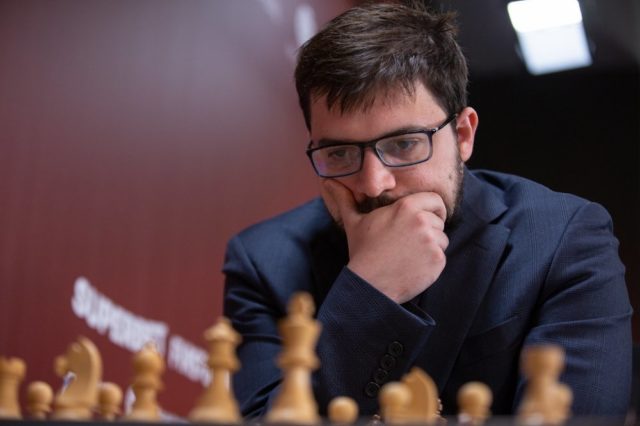
Round 5: NEPOMNIACHTCHI-MVL 1/2
Ian tried to surprise me in the opening with a very original move order, but after thinking about it, I realized that it would transpose into Sicilian 3.Bb5+ positions that I already knew.
After I comfortably equalized, Ian began to look for ways to continue the game. But that wasn’t what the position required, and he ended up being worse.
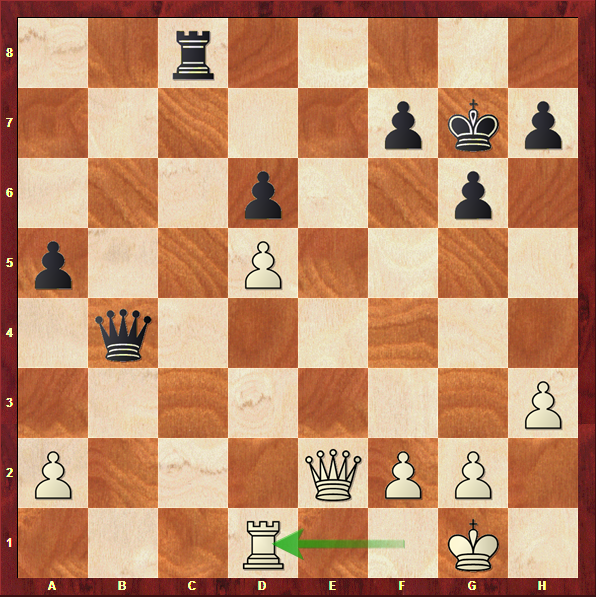
The d5 pawn is more vulnerable than its d6 counterpart and my heavy pieces are more active. But here I made the mistake of playing a little too easy. I know that this is something that is quite recurrent with me; often when I have the advantage, I don’t take the ten minutes necessary to ask myself what is the most accurate follow-up.
Here in particular, instead of 27…a4 28.g3 a3, which I could have postponed, I had the opportunity to start with 27…h5! before he could prevent me from putting my pawn on h4; with one pawn on h4, then the other on a3, I think black’s defense would have been much more difficult, and it’s quite possible that this detail could have made the difference.
Something similar happened in the final position:
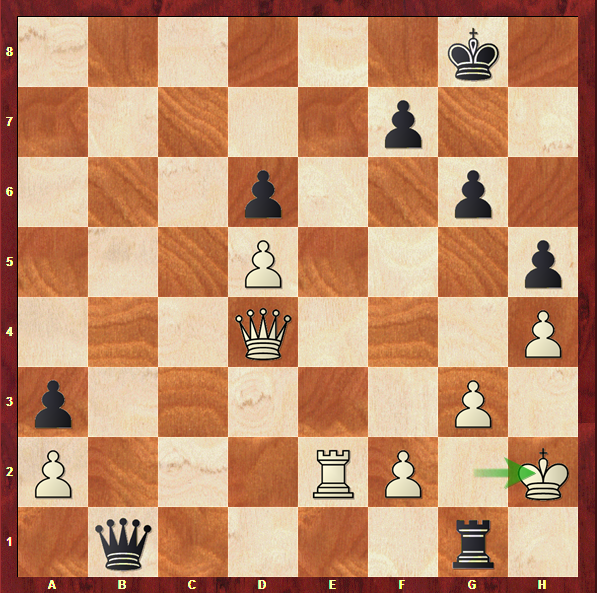
Without thinking too much, I accepted the draw by perpetual check after 41…Rh1+?! 42.Kg1 Rg1+, totally missing the possibility 41…Re1!, which would have already forced white to find the only move 42.Rd2; indeed if 42.Rxe1? Qxe1, the threat …Qe2 winning the a2-pawn can be parried only by giving up f2. And if 42.Qe3? Rxe2 43.Qxe2 Qb2! again black takes a2 or f2 and wins easily. After 42.Rd2, the Rook has been forced into total passivity, and even if white’s position remains solid, it is black who would have had every opportunity to continue causing problems.
Round 6: MVL-ARONIAN 0-1
I made the decision to play 1.d4 on the rest day before this game. So I had a lot of time to look at the lines on Levon’s favorite openings. But the problem with playing against a specialist is that he knows his patterns inside out. And it just so happens that I didn’t anticipate the move order he chose in the Queen’s Gambit, Vienna variation.
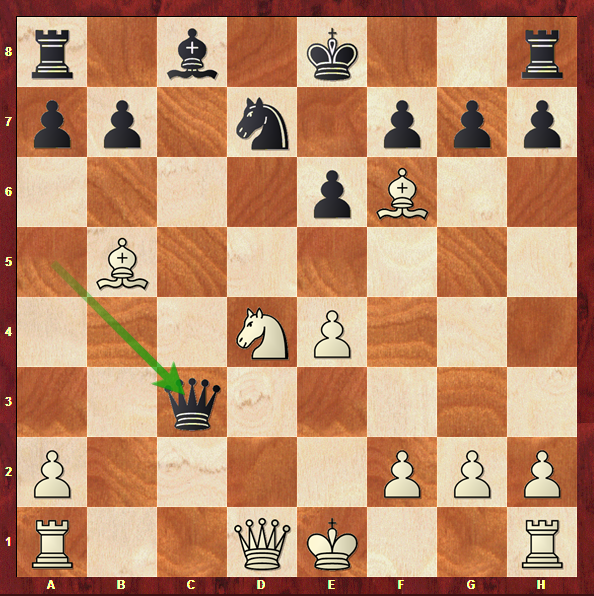
So, after thinking about it, I decided to avoid the big move 12.Kf1 in this position, which is one of the tabiya of the variation. Indeed, I had not reviewed the line for too long… After the rare 12.Ke2 Qb2+, my first intention was to play 13.Ke3 and settle for the draw after 13…Qc3+ 14.Ke2. But I saw the possibility 13.Qd2 Qxd2+ 14.Kxd2 gxf6 15.Rac1 0-0 16.Rc7? (both 16.Ke3 or 16.Rhd1 kept sufficient compensation for the pawn) and I thought I would never be worse there. But this was without the continuation 16…Rd8 17.Ke3 Nb6 with the idea …f5! and black takes a clear edge, taking advantage of the fact that white can never give up control of d5.
After 17…Nb6, I understood the problem and it was a bit of a panic. I didn’t defend this difficult position well and quickly lost…
Round 7: RAPPORT-MVL 0-1
An interesting game with a rather surprising, even improbable, transposition in the opening, from a Queen’s Gambit Accepted to one of the most popular line of the Meran in the 90s! Having had the opportunity to play this variation with white in the distant past, I at least knew that it was supposed to be ok for black, even if I couldn’t remember all the details.
Anyway, this is a type of position that requires a lot of calculation, and little by little I solved all the problems posed.
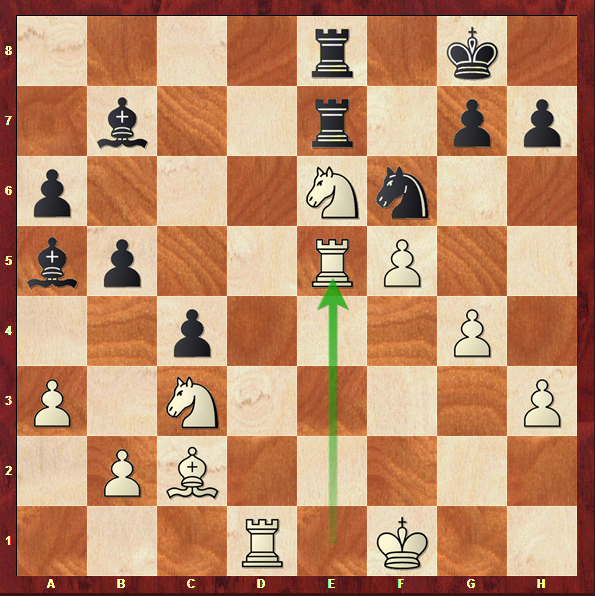
Here I found 27…Nd7! and thought I might be a little better, especially since I saw 28.Ree1 Nf8, challenging his only trump in the position.
This is the moment Richard chose to make what will probably remain as the blunder of the year: 28.Nd5?? Nxe5, forgetting that after 29.Nxe7+ Rxe7, white does not checkmate with 30.Rd8+ because the Bishop in a5 happens to control this square!

Round 8: MVL-DEAC 1/2
I chose a slightly marginal line against the Petrov’s 6…Bd6 variation.
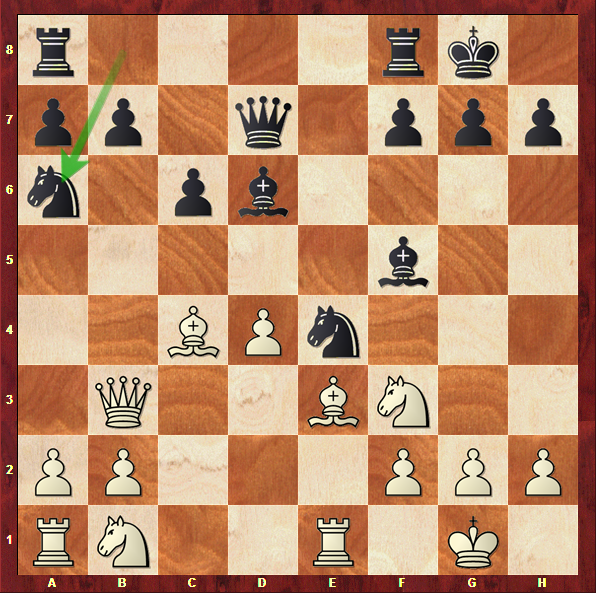
Here I knew his new move 12…Na6, and I recalled it was better for white, but I couldn’t remember how – a great high-level classic 🙂 . After 13.Ne5 Qc7, I chose 14.Nc3 which gave me a tiny edge. Black has to be very precise but he really played well and found ways to neutralize me.
By the way, Deac was particularly solid during the whole tournament, finishing at a very honorable 50%. Note a rather singular characteristic of the young Romanian: his propensity to be in zeitnot, and to systematically get up after each move, even with only 30 seconds on the clock, and whatever the complexity of the position!
Round 9: FIROUZJA-MVL 0-1
I knew I didn’t need to play for the win at all costs because he was going to do it anyway 🙂 . That’s why I didn’t expect 4.g3 against the Grunfeld at all.
After that, it became a bit of a cat-and-mouse game; I wasn’t willing to take too many risks but I wanted to give him options, even more so since I could see that he was taking a lot of time on his moves.
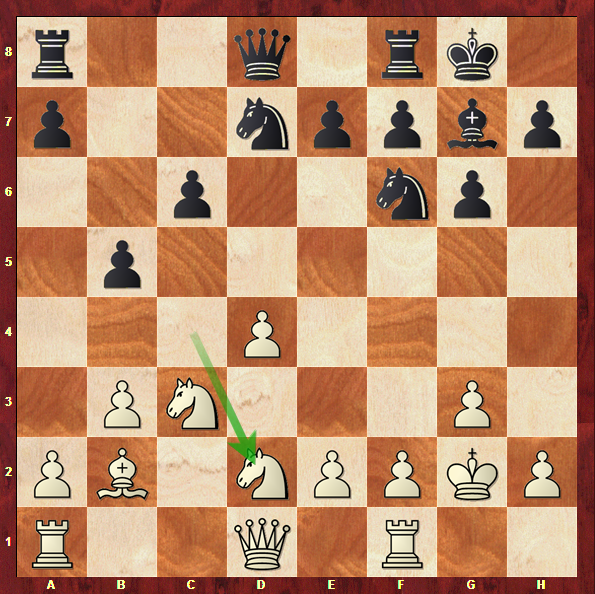
The first illustration of this approach can be found here, at the end of the opening. I knew I could play 13…Db6 followed by …c5, with probably a symmetrical structure and a comfortable equalization for black. But I chose the other break 13…e5!? which leaves more tension in the position.
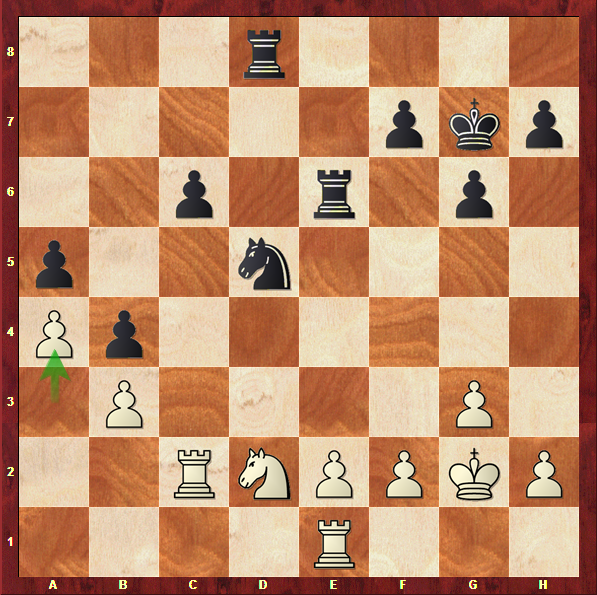
The second crucial moment is when I made the choice of 27…Re3!? in this position. Obviously, 27…Nc3 was normal, the position remaining roughly equal. But I felt that my move 27…Re3!? could send him into a tailspin as he started to run out of time. He reacted with the very natural and human 28.Rxc6, even though the machines prefer the timid 28.Rb2, forcing the exchange sacrifice 28…Rc3 (28…Ree8 29.Nc4 is not really what you want!) 29.Ne4 c5 30.Nxc3 Nxc3 with the idea …c4, and the position is not so clear in practice.
From the frustration I could see on his face, I think that after 28.Rxc6 Rc3 29.Nc4 Rxb3 30.e4 Re8, he calculated the continuation 31.Nd6 Re6 32.Rd1 Nf6 with the intention to play 33.Rc7?, before realizing that it was losing after 33…Rxd6! 34.Rxd6 Ne8. This explains in my opinion the other mistake 33.e5? and the fact that he didn’t find the moves that more or less kept the balance, 33.Rd4 or 33.Rc5.
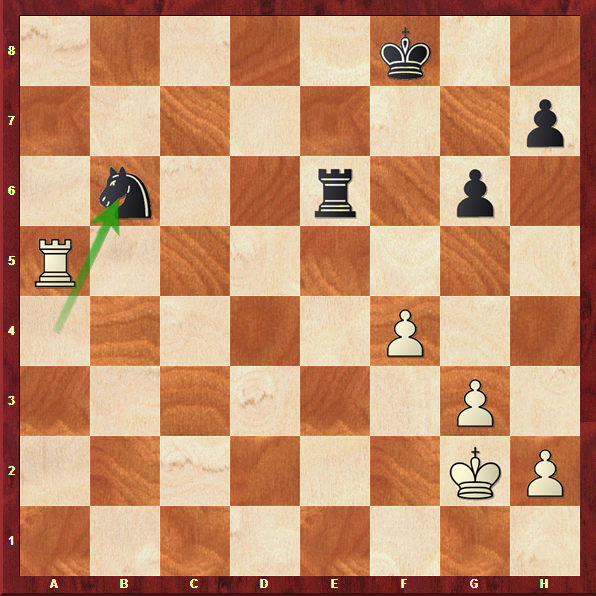
Finally my passed b-pawn cost him a piece and I got an endgame that I believe objectively winning. On the other hand, it poses big conversion problems for black, and thus offered real practical chances of a draw to the defending side. It would take a more precise analysis to determine if my conversion was clean and if Alireza missed better options…
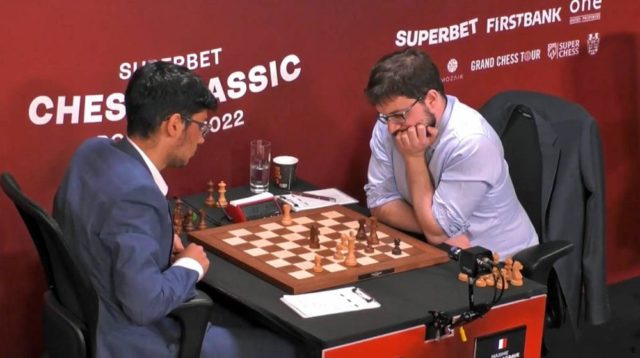
Having joined in extremis So and Aronian at 5.5/9, all three of us played a tie-break to determine the winner.
Tie-break 1: SO-ARONIAN 1-0
Tie-Break 2: MVL-SO 1-0
Tie-break 3 : ARONIAN-MVL 0-1
Fifteen minutes after the end of my game against Alireza, we were back to work, for my part without having had any time to prepare anything at all; and barely enough time to decompress, going back to my room for only a few minutes. I didn’t feel too much pressure though, as I knew that the Tour points would be shared (10 each); the extra $10,000 was not a priority for me, and honestly, my goal was mainly to add another line to my sporting achievements.
My two tiebreaker games were very high intensity tactical battles, there were a lot of incredible moments, I’ll just pick one per game.
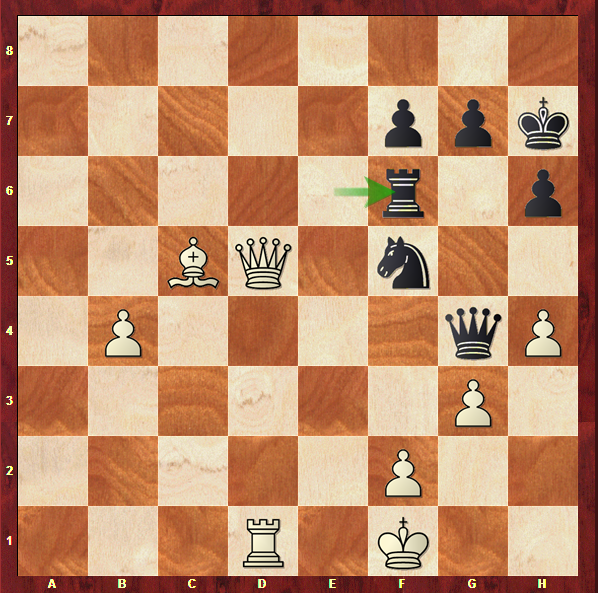
Here, I found the difficult (and brave 🙂 ) idea to run the King to the Queenside via e1 and d2. 35.Ke1! Re6+ 36.Kd2 and after many other adventures, I ended up converting my extra pawn.
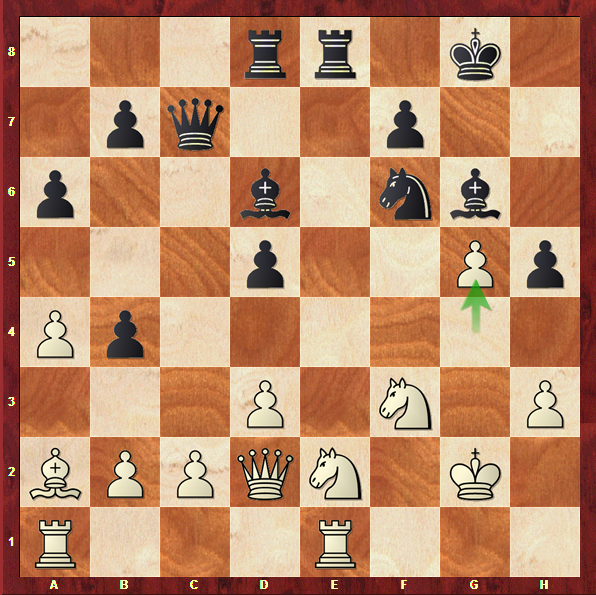
I sacrificed the Knight without hesitation with 25…Ne4! because I intuitively perceived that I would get a huge compensation. After many ups and downs there again, I ended up flagging Levon in a position that was winning again at that moment (exactly as against So by the way!).
In these two tie-breaks, despite the happy outcome, I felt that the fatigue of a long classical game could be felt. In particular, and this is a very clear sign for me, I had lost control of the time; usually, I have a clock in my head and in 10+5, I never find myself playing moves with only 1 second left; here it happened to me two moves in a row!
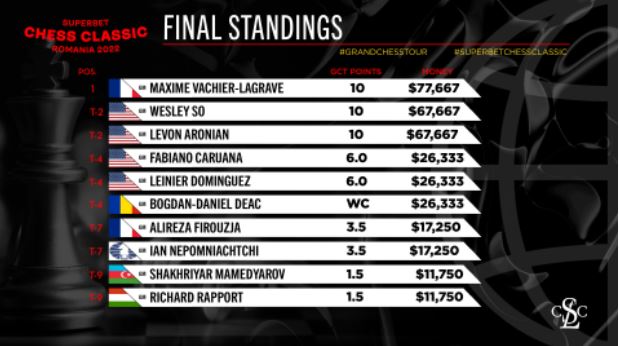
Finally, things turned in my favor and I am very happy to have started this Grand Chess Tour 2022 as I ended it in 2021, namely with a win in Classical chess!
I will resume the circuit on July 20th with the Rapid/Blitz tournament in Zagreb. In the meantime, the Norway Chess tournament starts on May 30th with its usual attractions, notably the Armaggedon game in case of a draw; but also its 2022 novelties, i.e. the return of the semi-retired Anand, Topalov and Wang Hao!
Maxime’s games
Rey Enigma is a Spanish youtuber whose identity is unknown. He always appears dressed in a black and white checkered jumpsuit that simulates a chessboard and completely hides his face. He uses a voice modifier in his public appearances. Only 6 people in the world know his true identity and he uses strict protocols to maintain his anonymity. At the beginning, he challenged onlookers in the parks of Madrid, but soon he was able to challenge some of the best players in the world, even getting to play Karpov in the Spanish version of the famous TV show « Spain’s got talent »; an opportunity for him to break the record for the most watched chess game in history!
Rey Enigma was present at the Grand Chess Tour in Bucharest to meet Kasparov. The day before the opening of the tournament, he challenged the world blitz champion MVL to a 1’-1’ blitz game. It took place on the terrace of a bar in the Romanian capital, and you can replay it here:
